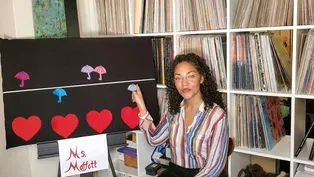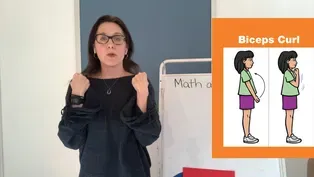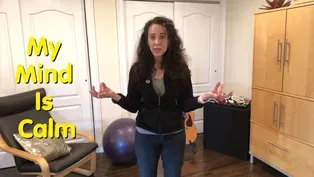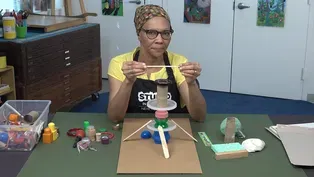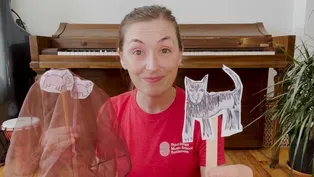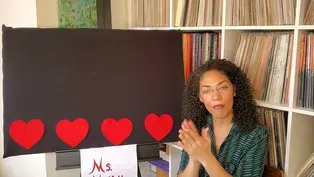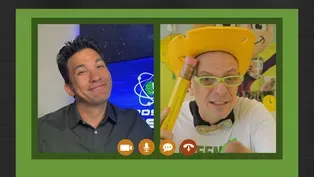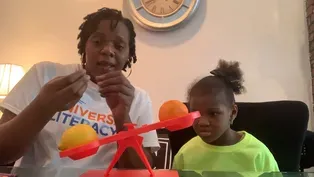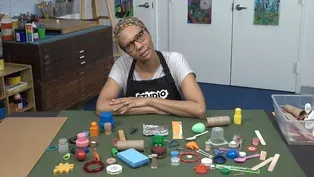
We Are Stronger Together!
5/28/2021 | 55m 20sVideo has Closed Captions
Learn to dance bomba and grow food in a city, read WOLF CUB’S SONG.
Learn to dance bomba and grow food in a city, read WOLF CUB’S SONG, decode suffixes -er, -est. LET’S LEARN helps children ages 3-8 with at-home learning. One-hour programs feature instruction by educators and virtual field trips.
Problems with Closed Captions? Closed Captioning Feedback
Problems with Closed Captions? Closed Captioning Feedback
Let's Learn is a local public television program presented by THIRTEEN PBS

We Are Stronger Together!
5/28/2021 | 55m 20sVideo has Closed Captions
Learn to dance bomba and grow food in a city, read WOLF CUB’S SONG, decode suffixes -er, -est. LET’S LEARN helps children ages 3-8 with at-home learning. One-hour programs feature instruction by educators and virtual field trips.
Problems with Closed Captions? Closed Captioning Feedback
How to Watch Let's Learn
Let's Learn is available to stream on pbs.org and the free PBS App, available on iPhone, Apple TV, Android TV, Android smartphones, Amazon Fire TV, Amazon Fire Tablet, Roku, Samsung Smart TV, and Vizio.
Providing Support for PBS.org
Learn Moreabout PBS online sponsorshipMore from This Collection
Video has Closed Captions
Read SCHOOL BUS and draw one, learn about prefixes and pitch, build sculptures. (57m 48s)
Running and Counting Both End in “ing”!
Video has Closed Captions
Move to improve, find the missing number, learn songs from Ghana, read ABUELITA’S SECRET. (58m 17s)
What Sound Does “aw” Make in Draw?
Video has Closed Captions
Read a story, discover "au" and "aw," learn about density, count, and move with music. (56m 58s)
Can You Find the Short “u” in Subtract?
Video has Closed Captions
Help Super Grover 2.0 solve a prickly problem, read ALL THE WAYS TO BE SMART. (56m 19s)
What Sound Does “gl” Make in Glove?
Video has Closed Captions
Play the glockenspiel, help Super Grover 2.0 make a cart move, read TWO WOOL GLOVES. (58m 9s)
Incredible Starts with Short “i”!
Video has Closed Captions
Solve problems with Super Grover 2.0, catch a rainbow, hear a piano sound like a cuckoo. (56m 9s)
What’s the Sound of “oo” in Book?
Video has Closed Captions
Explore animals’ form and function, sing about the 3 little pigs, read THE LITTLE BOX. (58m 15s)
We’re Reducing, Reusing and Recycling!
Video has Closed Captions
Learn all about rhythm and the number 9, read A BAG IN THE WIND. (56m 17s)
How Many Syllables are in Invent?
Video has Closed Captions
Invent your own instrument, make 10 to add numbers to 20, read ONE GOLDEN RULE AT SCHOOL. (57m 36s)
Video has Closed Captions
Learn about the science behind mind reading, count shells, read MY BIG FAMILY. (57m 27s)
Which is Heavier: One Apple or Two Apples?
Video has Closed Captions
Defy gravity, learn secret code words for fast and slow in music, read WHOOO KNEW? (58m 5s)
What’s the Sound of “nk” in Think?
Video has Closed Captions
Make beautiful stuff, learn all about the number 8, read LITTLE BUNNY’S BALLOON. (58m 44s)
Providing Support for PBS.org
Learn Moreabout PBS online sponsorship[bright upbeat music] - [Announcer] Ready to learn?
- Hi.
- Hi.
- [Announcer] It's time to share a story.
- Shh!
- [Announcer] Read and write.
- Let's read it back.
- [Announcer] Discover science.
Sing.
♪ Somewhere ♪ Play and so much more.
- Cupcake.
- Very good.
- [Announcer] Stay tuned for lessons and activities.
- We're gonna start making some words.
Isn't that fun?
- Mm-hmm.
[bright upbeat music] - [Announcer] Funding for this program was provided by the JPB Foundation.
[bright upbeat music] - Hello, my friends.
My name is Joseph Bruchac, and I'm the author of this new book called "Wolf Cub's Song" which I'm going to be reading to you today.
It's illustrated by Carlin Bear Don't Walk, who is a Cheyenne and Crow Artist from Northern Montana.
And I belong to the Abenaki Nation, the Nulhegan Band of the Abenaki.
And I'm going to share you a story, which has great meaning in all of our native nations, because to our people the wolf is not something to be afraid of, but is a very respected being.
And we can learn a lot from the wolves, for example, that wolves always take good care of their children and they do things together.
They share many things, including song.
And so, the story is called "Wolf Cub's Song."
And before I read it to you, I have to ask you something.
Have you ever felt alone like no one else was around?
That's what this story is a bit about.
Wolf cub was sad.
She felt alone and small.
She curled up inside her den into a furry ball.
"It is so very, very dark, I can't go play outside.
My friend, the sun, who shined his light on us has gone to hide."
I think we've all felt like that sometimes, haven't we?
Like we're alone, no one else is around.
What can we do?
But luckily just like wolf cub, we have people who take care of us, in this case, wolf cub's mother.
"I feel so all alone, alone, alone," poor Wolf Cub cried.
Just then mother wolf arrived and looked into the den.
"Do not be sad, my little one.
We're not alone," she said.
"Grandmother moon and all the stars are ready to dance up in the sky.
They're waiting for us to sing, my little one.
Come out and see."
Isn't it nice that she calls the moon, grandmother moon.
You know in many of our traditional stories, we talk about the fact that the moon is like a wise grandmother looking down on us from the night sky, and reminding us that even at night, we're not alone, that there is light somewhere shining on us, and that's the way grandmother moon is.
In fact wolves sing to grandmother moon as you'll see further on in this story.
Wolf Cub turned to peek outside, all the other wolves were waiting there.
"Wolf Cub," they called, "We need your help.
The moon and stars up in the sky wait now for us to come and sing, so they can dance up high.
We need your voice to sing with us and help complete our song."
"Can I really help you?"
Wolf cub asked.
"You certainly can," all the wolves agreed.
"You may be small but your voice is strong.
You're just a singer we all need."
That's important to remember, isn't it?
That even though you may be small, you can also add something.
In fact, in many of our stories, we talk about how the one who knows the answers, the one who has listened well and learned is the one who can solve some big problem that has come to the people.
In this case, the wolves are saying that little wolf is needed to make their song complete.
Wolf Cub leapt out of the den and ran outside.
The wolf pack guided her to the hill so high that it touched the sky.
"Are you ready now, my little one?"
Her mother asked.
Wolf Cub look up into the night, her heart felt happy and light.
Isn't that the way it is when you feel you have friends, or people are doing things with you.
You know cooperation and doing things together is a very important lesson to learn.
One voice or one person alone may not be able to do much, but when you put a lot of people together or a lot of voices together, it can be really strong, very powerful, just like wolves singing together.
Wolf cub sang her song then all the other wolves joined in.
None of us are alone is what they were singing as grandmother moon and all the stars above danced and danced.
One of our old traditions among my own Abenaki people is called a friendship dance.
When we do that dance, we join our hands together.
We dance in a circle, and as we dance in that circle, we all are connected.
All of us are part of the circle.
Behind me you can see some of my drums.
I always say the drum just like the story of "Wolf Cub's Song" teaches a lesson.
One of those lessons is that every part of the drum, if you're in a circle is equal to every other part but unique, that means different and special.
Just like each of you are unique, different, and special from everyone else.
Yet if you sit in a circle, everybody is the same distance from the middle of that circle.
And also if you show respect to everyone around you in that circle, that circle gets stronger.
Just like that song in that story got stronger, because Wolf Cub was singing along.
We also say that when you're in a circle, you look around, you can see everybody else's face, and you can recognize everyone else is part of that circle.
Think about that.
How different it is that when you're sitting in a straight line, or lined up, how some are far away and some are close, but in a circle, you're all connected together.
One of the things that I know, my illustrator and I have in common is that the wolf is very important to our people.
The wolf is sometimes described as a scout, the one who goes ahead and finds the way for the people to go, so we honor the wolf for that.
And I mentioned how wolves have strong families.
In fact, when you're in a wolf pack, all the grownup wolves take care of all of the children, so every Wolf in that pack is acting like a mother, and a father to the little ones.
So in that story, when Wolf Cub is called outside to sing with the other wolves, indeed that is just the way it is in wolf families, and you know, in our families too.
It's good when we include people together and share those things that we're doing.
One exercise you might try doing is a simple one where you dance in a circle.
If you all hold hands together, the circle is strong, you're all connected.
But if anyone lets go, the dancing has to stop.
And I thought I would share with you the sound of one of our simple songs and dances.
One that you could do together when you want to have a friendship dance and the song goes like this.
♪ Wigaiwane ♪ ♪ Wigaiwane ♪ ♪ Wigaiwane ♪ ♪ Wigaiwane ♪ ♪ Wigaiwane ♪ ♪ Wigaiwane ♪ ♪ Wigaiwane ♪ ♪ Wigaiwane ♪ Wait, let me walk over and get my drum, and you can hear the sound of the drum which is.
[drum music] That double beat is like the beat of the heart.
We say it's the first music everybody hears, because you're hearing your mother's heartbeat.
[drum music] And the song "Wigaiwane" with the drums sounds like this [drum music] ♪ Wigaiwane ♪ ♪ Wigaiwane ♪ ♪ Wigaiwane ♪ ♪ Wigaiwane ♪ ♪ Wigaiwane ♪ ♪ Wigaiwane ♪ ♪ Wigaiwane ♪ ♪ Wigaiwane ♪ Just that simple one, two, one, two, one, two.
It's like the heartbeat sound with the drum.
♪ Wigaiwane ♪ ♪ Wigaiwane ♪ ♪ Wigaiwane ♪ ♪ Wigaiwane ♪ ♪ Wigaiwane ♪ ♪ Wigaiwane ♪ ♪ Wigaiwane ♪ ♪ Wigaiwane ♪ Is that a nice song?
I always loved that song.
And when we sing it all together in a circle, all connected together, that song becomes even stronger.
And the meaning of that song is pretty simple, it is wigaiwane which means this is fun.
And it's been fun sharing with you a little information, and sharing with you my new book, "Wolf Cub's Song."
I hope that all of you will find someone to sing together with, to be together with, and to share with just as Wolf Cub does in this little story.
And now I'll say [speaks in foreign language] Which means I return good to you, or thank you, and [speaks in foreign language] means may you have a good journey wherever you go.
Goodbye now.
- Hi, Movers and Shakers.
This is Violet, and I'm here again, with my friend, Jeremy, and he's gonna help us sing a song.
First, I wanna shout out one of our friends, Durney who helps us read stories sometimes.
She requested this song, because she wanted us to spread some joy and positivity during these challenging times.
- Thank you, Violet, once again for having me come on and share a song with you about feeling good.
I have a question for you.
What are you doing when you're having a bad day?
- Hm, I like to laugh, or I play games with my friends.
I even like to sing and dance with them too.
- Nice.
That's so funny because I love those same things too.
I love hanging out and singing with my friends.
It always makes me so happy.
In fact, I have a song that I think you would love, and I think most of you would know.
If you do feel free to sing along, move your hands, dance in your seat, or jump up and down, and dance, and sing along with us, It's called "Can't Stop the Feeling."
♪ I got this feeling inside my bones ♪ ♪ It goes electric wavy when I turn it on ♪ ♪ And if you want it ♪ ♪ Inside your soul ♪ ♪ Just open up your heart ♪ ♪ Let music take control ♪ ♪ I got that sunshine in my pocket ♪ ♪ Got that good soul in my feet ♪ ♪ I feel that hot blood in my body when it drops ♪ ♪ Ooh ♪ ♪ I can't take my eyes up off it ♪ ♪ Moving so phenomenally ♪ ♪ The room on lock the way we rock it ♪ ♪ So don't stop ♪ ♪ And under the lights when everything goes ♪ ♪ Nowhere to hide when I'm getting real close ♪ ♪ When we move well you already know ♪ ♪ So just imagine ♪ ♪ Just imagine ♪ ♪ Just imagine ♪ ♪ Nothing I can see but you when you dance ♪ ♪ Dance ♪ ♪ Dance ♪ ♪ A feeling good creeping up on you ♪ ♪ So just dance ♪ ♪ Dance ♪ ♪ Dance ♪ ♪ Come on ♪ ♪ All those things I shouldn't do ♪ ♪ But you dance ♪ ♪ Dance ♪ ♪ Dance ♪ ♪ And ain't nobody leaving soon ♪ ♪ So keep dancing ♪ ♪ I can't stop the feeling ♪ ♪ So just dance ♪ ♪ Dance ♪ ♪ Dance ♪ ♪ I can't stop the feeling ♪ ♪ So just dance ♪ ♪ Dance ♪ ♪ Dance ♪ ♪ Come on ♪ - Thanks, everyone.
Thanks, Jeremy.
Hope you all had fun dancing.
[bright upbeat music] - Hello, friends.
I'm Dr. Rivers, and guess what it's time for.
Phonemic awareness.
As always you're going to need your eyes to watch, your ears to listen carefully, your mouth to saying repeat, and your hands to do some of the work.
We've been working with phonemes, which are the individual sounds that letters represent and syllables, which a word parts.
We may remember that every syllable has a vowel sound.
Today, we're going to work with syllables.
To put a little twist on it, we're going to pretend to bounce or dribble a basketball for the syllables, and we're going to shoot it to make the word.
Watch me do the first one.
Cas-tle.
When I blend the syllables in cas-tle I get the word castle.
It's your turn to try.
Bas-ket-ball.
Blend it.
Basketball.
Great job.
Now, let's try a few more, but first I'm going to add some pictures on the board.
When you blend the word that one of the pictures as on the board, I want you to point to the picture that the word represents.
Let's get started.
Tea-pot.
Blend it together.
Teapot.
There is the teapot.
Rab-bit.
Rabbit.
Do you see a rabbit?
Yes, here is a rabbit.
I-ci-cles.
Blend it.
Icicles.
When it's cold outside and it's been raining and snowing sometimes I have icicles on my roof.
Let's try another one.
Muf-fin.
Blend it.
Muffin.
Do you see a muffin?
Yes, sometimes I eat a muffin for breakfast.
Let's try another one.
Ko-a-la.
koala.
A koala bear is an animal found in Australia.
So cute, right?
Let's try another one.
La-dy-bug.
Ladybug.
When the flowers and leaves bloom in the spring, we often see ladybugs.
Let's try two more.
Pic-nic.
Blend it.
Picnic.
This family is having a picnic in the park or in the mountains.
One more.
Zip-per.
Blend it.
Zipper.
Sometimes we have a zipper on our jacket or on our coat, maybe our pants or shoes.
Great job, blending syllables to make words.
And now, let's do some work with suffixes.
The suffix, er and the suffix, est.
A suffix is a word part that we add to the end of a word to change its meaning.
First, let's clap some syllables in words that may have a suffix.
Say the word quicker.
When I clap the syllables in quicker, I clap quick-er.
[claps] How many times did I clap?
Two.
There are two syllables in quicker.
Say the word, shorter.
Now clap the syllables.
Short-er.
[claps] Two.
Slow.
Slow.
One.
Kitten.
kit-ten.
[claps] Duck.
Duck.
[claps] Sweeter.
Sweet-er.
[claps] Thickest, Thick-est.
[claps] Two.
Great.
Now, I'm going to say the word and you say the word parts, or the syllables in the word.
Weaker.
Weak-er.
Brightest.
Bright-est.
Kindest.
Kind-est.
Fast.
Fast.
Oldest.
Old-est.
Great job.
Now, take a look at these animals.
Horse.
Elephant... and giraffe.
What word could we use to describe these animals?
I would say... tall.
Tall is a word that describes... as in a horse is tall.
If I add the suffix... er, I get taller.
How many syllables are in taller?
Two.
An elephant is taller than a horse.
Tall.
Taller.
Tallest.
How many syllables in tallest?
A giraffe is the tallest of all three.
When I add the suffix, er, it compares two things.
The elephant is taller than the horse.
If I add the suffix, est, it compares three or more things.
The giraffe is tallest of all three.
Read the words with me again.
Tall.
Taller.
Tallest.
The horse is tall.
The elephant is taller.
The giraffe is tallest.
Great job.
Now... let's try another word.
Read this word.
Strong.
The baby is strong.
His big brother is stronger.
His dad is strong-est.
Compare, the baby is strong.
Comparing two, his brother is strong-er.
The baby and his brother.
Strong-est, comparing three or more.
His dad is strong-est of them all.
Great job.
Now, let's do some reading of words with the, er, and the, est suffixes.
When I look at this word...
I know...
I noticed that I see that ee vowel team and I see the er suffix added to the end to change the meaning.
I separate these words by the base word and the suffix.
Deep-er.
How many syllables?
Two.
Deep-er.
The word deeper.
The ocean is deeper than the pool.
Comparing two things.
When I add this... once again I see my vowel team and my suffix.
If I put them together, I get... Deep-est.
The pool is deep.
The pond is deeper.
The ocean is deepest.
Great job with suffixes today, the suffix, er, and the suffix, est.
We use these suffixes to compare.
Kiss your brain.
Share what you learned today with someone that you love, and don't forget to come back again.
There's so much more to learn.
See you soon.
[bright music] [mother speaking in foreign language] - Like a pilgrim of himself.
- Yeah, like a pilgrim of himself.
[mother speaking in foreign language] - The farms are beautiful.
[mother speaking in foreign language] There can be no spring.
[mother speaking in foreign language] - Ian, do you know what counsel means?
- Counsel?
[mother speaking in foreign language] - What do you think is happening?
- Blades will never melt.
- Okay.
- And neither will the ice.
[mother speaking in foreign language] [bright upbeat music] - Hi, students.
When I come outside on my terrace and look at the city, I don't see just rooftops, I see amazing places to plant food.
And that's why I'm so excited to be with you today to read a book written by my hero, Will Allen, Farmer Will Allen, and his book called the "Growing Table."
Because even though my friend Will lives in the country, I live in the city, but everywhere we can grow food, so, I'm excited to read to you today.
And in fact, my friend Will even sent me an autographed copy of Will Allen's, "Growing Table."
I'm excited.
Farmer Will Allen.
Farmer Will Allen is as tall as his truck.
He can hold a cabbage or a basketball in one hand.
And when he laughs, everyone laughs.
Glad to be in his crew.
And when he talks, everybody listens.
But some say the special thing about Will Allen is that he can see what others can't see.
Are they right?
When he looked in an abandoned city lot, he saw a huge table heaped with food.
Was he right?
The kitchen table.
When will Allen was a boy, bowls of peas, greens, and his favorite lime of beans with ham covered his kitchen table.
"My mother often fixed enough food for 30," Will says.
"We never had a car or a TV, but we always had good food."
He remembers people who'd come to dinner tired and drooped, and leave laughing.
That's the power of good food.
Will's family grew most of their own food.
Will loved the good food, but hated the work.
He planned to quit on planting, pickling, and pulling weeds, and leave those Maryland fields for basketball, or a white shirt work, and so he did.
He graduated from college, and he moved to Belgium to play professional basketball.
When a Belgian asked him to dig potatoes, Will realized he loved digging in the dirt.
He grew so much food that he and his wife, Cindy covered the kitchen table with Thanksgiving dinner for a team of their basketball friends.
A New kind of Farm.
When Will was done with basketball, he worked a white shirt job in Wisconsin, and found time to grow vegetables on Cindy's parents land, but Will wanted his own place.
He'd seen that fresh vegetables were scarce in the city as trout in the desert.
Will believed everyone everywhere had a right to grow good food.
But how?
How would Will farm in the middle of pavement and parking lots?
One day while driving in Milwaukee, Will spotted six empty greenhouses on a plot of land about the size of a supermarket for sale.
He could see kids who'd never eaten a ripe tomato, never crunched a raw green bean sitting at his table.
Will Allen bought the whole city lot.
The dirty soil.
Will had a start on his table.
He had the land, but the table was empty.
The problem was Will's soil was dirty with chemicals and pollution.
He had no money for machines to dig out the bad soil for truckloads of good soil.
What to do?
In Belgium, Will had learned to make good soil with food garbage, they called it composting, but he needed lots of garbage.
He asked his friends to save food waste, apple peels to old zucchini.
Will collected those scraps in big white buckets and dump them into piles.
He added, A, leaves, newspapers, and red wiggler worms, and water.
Every now and then he turned the piles into the air to get the mix.
Neighborhood kids stopped by to ask what was he doing.
Will told them about the piles and the red wiggler worms, that we hope the garbage become compost.
The kids came back day after day to help.
Red Wiggler Worms.
Then one day, bad, sad news, the red wiggler crew was dying.
Will and the kids studied worms for five years.
They learned not to feed the worms too much, and they discovered the best menu for red wigglers, no hot peppers, onions, garlic, but lots of watermelon rinds, sweet potato scraps, molasses.
Since then the squirmy crew has stayed hard at work.
Will says worm magic is what makes his farm grow.
Making a Bigger Table: Growing Power.
Once Will had good soil, he was ready to plant vegetables.
He didn't have too much space, but how could he grow enough food on a small city plot?
Will look all around.
He saw that he had all this space from the soil under his feet to the top of the greenhouses.
He hung baskets from the ceiling.
He grew greens in buckets, greens in rows.
He crowded shelves with pots of spinach, chard and lettuce.
He grew stacks of tiny salad sprouts in boxes, hundreds of boxes.
Will added hoop houses to hold more boxes and added more long rows of vegetables.
He added vats to water and fish to his greenhouses.
Fish, waste, water grows the sprouts.
The sprouts clean the water for the fish.
Fish, water, sprouts work together like a three-part farm machine.
He added goats, and chickens, and turkeys, and bees to that city farm he named Growing Power.
Finding Farmers.
Farmer Will's work clothes are jeans and a blue sweatshirt with cutoff sleeves.
He's busy from early morning to night.
Still, one person could never grow all the food Will wanted to grow.
Where could he find more farmers in the middle of a city?
Will looked around, and around, and around.
He saw a teenagers, schoolchildren, parents and grandparents.
He taught them to be farmers.
Then Will's table held as much as several supermarkets, thousands of pounds of food.
Neighbors who live in far off high rises, growing off the ground came, and still come to Will's farm to buy fresh vegetables, fish or eggs.
People have gone and still go to fancy restaurants to eat Will's food.
But Will wanted his table to feed folks all over the world.
How could he build one huge table that crossed continents?
Growing Power Around the World.
Will thought about the problem of the world-sized table.
He looked around and he saw many helpers who'd learned to be farmers.
He would teach people everywhere to grow food for their own tables.
Will began to travel.
He crisscrossed the United States.
He has taken his red wigglers to Kenya, to London, all over the world.
The world has also come to his Milwaukee farm.
20,000 visitors a year tour the greenhouses, watch goats, snack on greens, and go home planning to start a farm in a city lot, a rooftop, or abandoned highway.
Will and the 50 million.
Is Will Allen done?
"Never, we need 50 million more people growing food on porches, in pots, inside yards," he says.
Will is always looking for new ways to make the table bigger, more schoolyard plots, a vertical farm that's five stories high, farms in empty factories or warehouses.
Will Allen dreams of a day when city farms are as common as streetlights, and every table is covered with good food.
This is one of my favorite pictures.
Your Table.
Will Allen can see what others can't see.
When he sees kids, he sees farmers.
Will you be on Will's crew?
Will you grow vegetables for your family, on your neighbors, on your porch, or roof or yard?
How big will your table be?
I'm so proud to have read this book to you, and Will is one of my personal heroes.
I've always wanted to be like Will Allen, and in fact, I wrote him a letter when I was a boy and 50 years later, I got to meet Will and he taught me all about farming and now I farm.
In fact, Will inspired me to write my book about farming, and here it is.
And my big dream is to write a book where my farm meets Will's farm, and he and I farm together forever.
When I look at shy here in New York City, I don't see rooftops.
I see amazing places for all of us to plant food.
Thanks for joining me today and I'll see you soon.
Bye-bye [bright upbeat music] - Hi.
I'm Barry from the Dance Education Laboratory of the 92nd Street Y.
We're gonna dance today.
We're gonna do a special dance with a special friend of mine who's from an enchanted island.
I wonder if you can guess what Island she's from.
Okay, how about we warm up and then you can meet her and learn the dance.
Let's go.
Okay, take your fingers, we're gonna wake ourselves up.
Here we go, we're gonna poke, poke, poke, poke, poke.
Let's go twice as fast.
Poke, poke, poke, poke, poke, poke, poke.
Let's go very fast.
Poke, poke, poke, poke, poke, poke, poke, poke poke.
And your shoulder, excuse me, pardon me.
Excuse me, pardon me.
Excuse me, pardon me.
Excuse me, pardon me.
Hey, what do you want?
And poke your cheeks.
[lip-trilling] And your head.
[clicking] And your back.
[clicking] And pat your legs, pat, pat, pat, pat.
Twice as fast.
Pat, pat, pat, pat, pat, pat, pat.
Really fast.
Pat, pat, pat, pat, pat, pat, pat, pat, pat, pat, pat, pat.
Good job, good job.
Thank you.
[lip-trilling] And your head, pong, pong, pong, pong.
And your back, boom, boom, boom.
And let's squeeze, squeeze, let's squeeze, squeeze, squeeze, squeeze.
Now, go squeeze, squeeze, squeeze, squeeze, squeeze, squeeze, squeeze.
And fast squeeze, squeeze, squeeze, squeeze, squeeze, squeeze, squeeze, squeeze, squeeze.
And your shoulders, coqui, coqui.
And your other shoulder, coqui, coqui.
Hey, that sounds like a frog I know.
Hey, no frogs allowed in school.
Okay, squeeze your cheeks.
[lip-trilling] And your nose, honk, honk.
And your head, beep, beep.
And your back boop, boop.
Now, can you wiggle your head?
Can you wiggle your bottom?
And your head and your bottom together?
And wiggle your shoulders, and wiggle your knees.
Can you wiggle your shoulders and your knees?
That's tricky.
Can you wiggle your head, and your bottom, and your shoulders, and your knees?
Wow, you're so wiggling.
How about your elbows and your knees?
Yeah.
How about we wiggle everything?
[lips thrilling] And now can you open yourself super wide, take a big breath in.
[inhales] And we're gonna pop ourselves like a balloon and pop to the ground we just pop.
[lips trilling] Let's do a pop with a turn, ready?
[inhales] Pop!
[lip-trilling] Nice.
Let's do a pop with a jump, ready?
One, two, three, pop.
[lip-trilling] And now one last crazy, super, silly pop.
[inhales] Pop!
[mumbles] Now, I'd like to introduce you to my friend Milteri from Puerto Rico, the enchanted island.
She's gonna teach us Bomba.
Let's go dance with her.
[drum beats] [Milteri speaks in foreign language] My name is Milteri Tucker Concepcion and I am from Ponce, Puerto Rico.
- And I am Kidd Ore from the Bronx.
- And I am Will from Brooklyn.
- And together we are Bombazo Dance Company.
And today, we are going to learn about Puerto Rico and our African ancestry, La Bomba Puertorriquena.
Puerto Rico is the enchanted island, La Isla del Encanto, where the native Taíno Arawaks named our island Borikén.
It has waterfalls, rivers, fortresses and most importantly, we have our little treasure which is the little tree frog that sings his name coqui, coqui.
Bomba dates back to the 17th century where it was practiced and maintained by the enslaved and the free people of color around the coastal plantations of sugar and coffee.
It is song, dance and drum.
Part of the instrumentation is what you see here.
We have the barril de bomba.
And this particular drum is called a primo or subidor, which is the lead drum that plays on top of the rhythm.
And here we have buleador, and the buleador is the one that maintains the rhythm.
Now, the dancing is a conversation between lead drummer and the dancer that comes into the open space we call El Batey, and it is where the drummer follows the dancers.
For example, if I'm moving my shoulders up and down the drum sets.
[drum music] If I move my head left and right the drum sets.
[drum music] I can move my hips.
[drum music] I can move my feet.
[drum music] And I can use my sombrero, a handkerchief, or on this case, a bomba skirt like this.
[drum music] Also the shoulders go into play.
[drum music] [Ore laughs] And it is the dancer that becomes in this space, the drummer.
So, are you ready?
Here we go.
Let's start with Bomba Sicá.
Now, Bomba Sicá is a four, four rhythm and it's steps, the steps are you step with your right leg, tap with your right leg, and you're going to tap your left, so your heels are off the floor.
And you just tap just a little bit in front each other slightly.
And it goes one, and one, and one, and one.
So, let's start with the feet together.
Your hands are placed on the hips.
We're gonna stay forward in place, in place for forward, and then we're gonna to do it forward, four times forward and then back, and we're going to salute with the drummer.
And the drummer, he gets saluted in front of your screen.
The drummer is right next to me, the lead drummer, and we do this as a form of reverence, as a form of him acknowledging that I'm going to control his hands.
- Oh!
[Maltier laughs] [drum music] - Yes, let's try this again.
Let's get into Bomba basic, feet together, hands on your hips.
Here we go.
[drum music] And slow.
Four steps forward.
Five, six, seven, and one, two, three, take it back.
One, two, three, and forward, and one, two, three, four, and back.
Two, three.
Now let's salute.
[drum music] Okay.
[drum music] Great job, everyone.
That is the step to the rhythm of Bomba Sicá, right?
That's how we come into the open space, we call El Batey and then we salute.
Now, we start talking, and how do we talk?
We use our body parts.
So, the first thing we're gonna do is use our hands moving forward.
We're gonna start with right for forward.
It comes from your hips and see how Mr.
Ore is going to follow me.
And one.
Two.
Three.
Four.
That's it.
I'm gonna do it sideways so you can see me.
Six.
Seven.
Eight.
And... [drum music] That's called piquete forward.
Now, we are going to add another step.
We're going to do the flick.
It's just your hands moving, just flicking forward.
One, two.
One, two.
One, two.
Mr.
Ore, here we go.
[drum music] Then we are gonna shake our arms like this.
[drum music] Side to side.
And this is called the roll, we are going to roll.
[drum music] So you can do this with a skirt, with a scarf, with a handkerchief, or just with your body part.
Which body part are we using?
Yes, our arms and our hands.
Here we go, let's try that again, Ore.
Wait, after we salute, we're going to have piquete forward and... [drum music] Flick double it.
[drum music] Roll fast to the beats.
[drum beats] And...
Wait, oh, this is called the open, We're gonna put your arms in ballet position or an A shape just like this, and we're going to just bring your arms down.
[drum music] Again, A shape and bring it down.
[drum music] Let's put all those three together.
Six, seven, eight.
We started with the drummer and we go.
[drum music] Flick.
[drum beats] Roll.
[drum music] And open.
We're gonna move forward, I call this the chuchu forward, and we're just gonna drag our feet forward, caressing, and kissing the floor.
[drum music] And we're gonna take it back.
[drum music] As we go back, our torso leans forward a little bit and we're leading with our hips.
So, moving forward, we'll open our skirt and our scarfs or you open your hands.
[drum music] And the going back we place it in front and our torso leans towards the floor.
[drum music] And then we do one chest pump.
[drum music] And it's all on with the arms.
Okay, let's do it now with the actual rhythm.
We'll have the buleador joining with the music.
Here we go.
I'll be ready, we're gonna get ourselves into Bomba positions.
First I will do it without the skirt and then we'll do it with the skirt.
Here we go.
[drum music] Basic step.
[drum music] Salute.
[drum music] Here we go.
[drum music] Flick.
[drum music] Roll.
[drum music] Open.
Basic step.
[drum music] Chuchu forward.
[drum music] Take it back.
[drum music] And...
Relax.
I salute again.
Again, five.
Six.
Seven.
Eight.
Salute.
And... [drum music] Flick.
[drum music] Roll.
[drum music] Basic step.
[drum music] Chuchu forward.
[drum music] Take it back.
[drum music] And... salute.
And so... And so great job, everyone.
It's also really important that once we finish our dance, we salute the drummer.
And that means that we're done, so we say this for hello.
Are you ready to follow me?
And when we're finished, you say thank you as a form of following our movement, and our interpretation.
Now, we've gone to the part where you're going to create your own Bomba movements, and you can actually put this in a different order.
So, let's say, for example, you wanna start with a pump.
[drum music] And you say, well, I wanna do more than one.
You can do more than one.
[drum music] You can do one elbow [drum music] at a time.
Or you can go faster.
[drum music] Or you can add the hand after that.
[drum music] And the goal is to kind of try to trick the drummer, but also you can add your own movement, whatever you want to create, right?
For example, if you wanna add a little bit of a shimmy.
[drum music] Right, shoulders up and down.
[drum music] Move your head up and down.
[drum music] Or say no.
[drum music] You can turn.
[drum music] Or you can add a little.
[drum music] [Milteri laughs] Or a little.
[drum music] Whatever you want.
And now, I'm going to dance bomba my own interpretation.
Why?
Because the drummer follows the dancer.
And it's what I'm feeling is a conversation, is an improvisation with the language I just taught you.
Okay.
Here we go.
Let's make that drum talk.
[drum music] Thank you so much for joining us, and that you've learnt a little bit about our African heritage, La Bomba Puertorriquena.
Thank you.
Until next time with Bombazo Dance Company.
[drum music] - Did you have fun dancing Bomba with Milteri?
Did you make those drums talk?
I bet you did.
[gasps] You used dance to communicate.
Did you know?
You can make a dance about anything that expresses anything.
Well, I hope you keep expressing yourself with dance.
I hope you had fun with us.
Have a great day.
[bright upbeat music] - [Announcer] Funding for this program was provided by the JPB Foundation.
[bright upbeat music] [chiming music]
Let's Learn is a local public television program presented by THIRTEEN PBS
